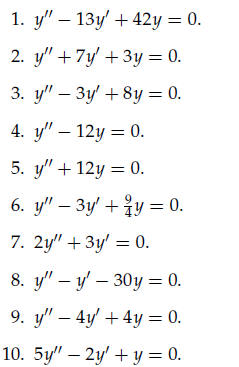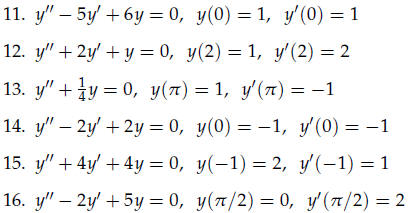Stony Brook University Mathematics Department
1. The general second order homogeneous linear differential equation with
constant coefficients
looks like
Ay'' + By' + Cy = 0,
where y is an unknown function of the variable x, and A, B, and C are constants.
If A = 0
this becomes a first order linear equation , which we already know how to solve.
So we
will consider the case A ≠ 0. We can divide through by A and obtain the
equivalent
equation
y'' + by' + cy = 0
where b = B/A and c = C/A.
“Linear with constant coefficients” means that each term in the equation is a
constant
times y or a derivative of y. “Homogeneous” excludes equations like y'' +by' +cy
= f (x)
which can be solved, in certain important cases, by an extension of the methods
we will
study here.
2. In order to solve this equation , we guess that there is a solution of the
form

where λ is an unknown constant. Why? Because it works!
We substitute  in our equation. This gives
in our equation. This gives

Since  is never zero , we can divide through
and get the equation
is never zero , we can divide through
and get the equation

Whenever λ is a solution of this equation ,
 will automatically be a solution of our
will automatically be a solution of our
original differential equation, and if λ is not a solution, then
 cannot solve the
cannot solve the
differential equation. So the substitution  transforms the differential equation into
transforms the differential equation into
an algebraic equation !
Example 1. Consider the differential equation
y'' − y = 0.
Plugging in  give us the associated equation
give us the associated equation

which factors as

this equation has λ = 1 and λ = −1 as solutions. Both
 and
and
 are solutions
are solutions
to the differential equation y'' − y = 0. (You should check this for yourself!)
Example 2. For the differential equation
y'' + y' − 2y = 0,
we look for the roots of the associated algebraic equation

Since this factors as  , we get both
, we get both
 and
and  as
solutions to
as
solutions to
the differential equation. Again, you should check that these are solutions.
3. For the general equation of the form
y'' + by' + cy = 0,
we need to find the roots of
 , which we can do
using the quadratic formula
, which we can do
using the quadratic formula
to get

If the discriminant b2 − 4c is positive, then there are two solutions, one for
the plus sign
and one for the minus.
This is what we saw in the two examples above.
Now here is a useful fact about linear differential equations: if
 and
and  are
solutions
are
solutions
of the homogeneous differential equation y'' + by' + cy = 0, then so is the
linear combination
 for any numbers p and q . This fact is easy
to check (just plug
for any numbers p and q . This fact is easy
to check (just plug 
into the equation and regroup terms; note that the coefficients b and c do not
need to
be constant for this to work. This means that for the differential equation in
Example 1
(y'' − y = 0), any function of the form
 where p and q are any constants
where p and q are any constants
is a solution. Indeed, while we can’t justify it here, all
solutions are of this form. Similarly,
in Example 2, the general solution of
y'' + y' − 2y = 0
is
 where p and q are constants.
where p and q are constants.
4. If the discriminant b2 − 4c is negative, then the equation
 has
no solutions,
has
no solutions,
unless we enlarge the number field to include , i.e. unless we work
, i.e. unless we work
with complex numbers. If b2 − 4c < 0, then since we can write any positive
number
as a square k 2, we let k2 = −(b2 − 4c). Then ik will be a square root of b2 −
4c, since
(ik)2 = i2k2 = (−1)k2 = −k2 = b2 − 4c. The solutions of the associated algebraic
equation
are then

Example 3. If we start with the differential equation y'' + y = 0 (so b = 0 and
c = 1) the
discriminant is b2 − 4c = −4, so 2i is a square root of the discriminant and the
solutions
of the associated algebraic equation are
 = i and
= i and
 = −i.
= −i.
Example 4. If the differential equation is y'' + 2y' + 2y = 0 (so b = 2 and c =
2 and
b2 − 4c = 4 − 8 = −4). In this case the solutions of the associated algebraic
equation are
λ= (−2 ± 2i)/2, i.e.
 = −1 + i and
= −1 + i and
 = −1 − i.
= −1 − i.
5. Going from the solutions of the associated algebraic equation to the
solutions of the
differential equation involves interpreting
 as a function of x when λ is a
complex
as a function of x when λ is a
complex
number. Suppose λ has real part a and imaginary part ib, so that λ = a + ib with a
and b
real numbers. Then

assuming for the moment that complex numbers can be exponentiated so as to
satisfy the
law of exponents. The factor  does not cause a problem, but what is
does not cause a problem, but what is
 ?
Everything
?
Everything
will work out if we take

and we will see later that this formula is a necessary consequence of the
elementary properties
of the exponential, sine and cosine functions.
6. Let us try this formula with our examples.
Example 3. For y'' + y = 0 we found  = i and
= i and
 = −i, so the solutions are
= −i, so the solutions are

and  . The formula gives us
. The formula gives us
 and
and  .
.
Our earlier observation that if
 and
and
 are solutions of the linear
differential equation,
are solutions of the linear
differential equation,
then so is the combination
 for any numbers p and q holds even if p and
q
for any numbers p and q holds even if p and
q
are complex constants.
Using this fact with the solutions from our example, we
notice that 
and  are both solutions. When we are given a problem with real
are both solutions. When we are given a problem with real
coefficients it is customary, and always possible, to exhibit real solutions.
Using the fact
about linear combinations again, we can say that y = p cos x+q sin x is a
solution for any
p and q. This is the general solution. (It is also correct to call
 the general
the general
solution; which one you use depends on the context.)
Example 4. y'' +2y' +2y = 0. We found
 = −1+i and
= −1+i and
 = −1−i. Using the formula
= −1−i. Using the formula
we have

Exactly as before we can take  and
and
 to get the real solutions
to get the real solutions

and  . (Check that these functions both satisfy the differential
equation!) The
. (Check that these functions both satisfy the differential
equation!) The
general solution will be  .
.
7. Repeated roots. Suppose the discriminant is zero: b2 − 4c = 0. Then the
“characteristic
equation”  has one root. In this case both
has one root. In this case both
 and
and
 are
solutions of the
are
solutions of the
differential equation.
Example 5. Consider the equation y'' + 4y' + 4y = 0. Here b = c = 4. The
discriminant
is b2 − 4c = 42 − 4 × 4 = 0. The only root is λ = −2. Check that
both  and
and
 are
are
solutions. The general solution is then  .
.
8. Initial Conditions. For a first-order differential equation the undetermined
constant
can be adjusted to make the solution satisfy the initial condition
 ; in
the same
; in
the same
way the p and the q in the general solution of a second order differential
equation can be
adjusted to satisfy initial conditions. Now there are two: we can specify both
the value
and the first derivative of the solution for some “initial” value of x.
Example 5. Suppose that for the differential equation of Example 2, y'' + y' −
2y = 0, we
want a solution with y(0) = 1 and y'(0) = −1. The general solution is
 ,
,
since the two roots of the characteristic equation are 1 and −2. The method is
to write
down what the initial conditions mean in terms of the general solution, and then
to solve
for p and q. In this case we have

This leads to the set of linear equations p+q = 1, p−2q = −1 with solution q =
2/3, p =
1/3. You should check that the solution

satisfies the initial conditions.
Example 6. For the differential equation of Example 4, y'' + 2y' + 2y = 0, we
found
the general solution  . To find a solution satisfying
the initial
. To find a solution satisfying
the initial
conditions y(0) = −2 and y'(0) = 1 we proceed as in the last example:

So p = −2 and q = −1. Again check that the solution

satisfies the initial conditions.
Problems cribbed from Salas-Hille- Etgen, page 1133
In exercises 1-10, find the general solution. Give the real form.

In exercises 11-16, solve the given initial-value problem.




